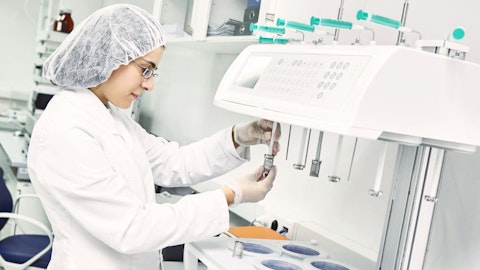Operator: Next, we’ll go to Eve Burstein from Bernstein Research. Please go ahead.
Eve Burstein: Hi, there. Good morning. Thanks for taking the question. Two questions. One, both high growth, growth adjacency related. So for Wyatt, it seems not to have felt as much pressure as your core instruments. And it makes sense that there wouldn’t have been as much COVID pull forward there as in LC, for example. But are you still seeing lengthening sales cycles and some of those same signs of demand weakness for Wyatt Technology? And then for the other high growth adjacencies, you’ve mentioned a couple of times about reinvesting funding investments affecting your adjusted operating margin. Can you talk about how the pressures in the industry and pressures on your top line have potentially lengthened some of the timelines that you’re looking at to go after those high growth adjacencies?
Udit Batra: Thanks for the question, Eve. I’ll start with the Wyatt question. Look, I mean, we’re very pleased with the way the integration is going. I mean, that should be the general takeaway and you can see that in the facts, right, basically a 4% contribution this quarter and 2.5% for the year. So we think we are going to deliver that. And when you look at the drivers, the integration is growing faster than we had initially even imagined. There are exactly the same headwinds. The funnel velocities are longer. It is taking more time for customers to place orders. But number one, given the larger commercial field force that Waters had, we were able to use that to generate a lot more leads for our light scattering instruments from Wyatt, which are highly differentiated in the market.
So as we got more leads, we got more conversions and the funnels moving nicely through. Second, we’ve spent a lot of time in making it easier for customers to connect Waters as LCs to multi-angle light scattering instruments from Wyatt, and that’s well ahead of target. And third, we had talked earlier when we talked about the synergy contributions, we had talked about columns from Waters being substituted for other competitors columns and that’s gone extremely well. So every light scattering equipment that is sold now is sold with a Waters SEC column, which are the best-in-class. So integration going very well, but the largest driver, I would say, of short-term results and overcoming the obvious headwinds is the larger number of leads that are Waters account managers have provided the Wyatt specialists.
And as you look ahead, I mean, really optimistic about what we are seeing with the collaboration across the two organizations. Our Wyatt colleagues were present at the Innovation Summit recently, which basically invites over 300 or so R&D scientists around the globe for a hybrid session. We had many posters from Wyatt colleagues looking at collaborations across the organization. So I’m extremely pleased with where things are going. And we recently launched the ZetaStar, which combines three light scattering technologies into one. So Wyatt’s going extremely well, and thank you for the opportunity to expound on that. Now, on the high growth adjacencies, the 30.5% operating margin that we are committing to for the full year includes the 70 to 80 basis points that we had said that we would invest, we had started to invest that early in the year.
We are seeing very nice outcomes of that, especially in our clinical business where the team has developed many, many assays, simplified workflows for difficult to do experiments with LCMS and making it a much more easier experiment for customers who want to use LCMS in specialty diagnostics areas like for Alzheimer’s testing – like for testing antibodies for Alzheimer’s as just a case in point. So the high growth adjacencies are delivering. Now we will look at the net picture as we look at the full year and how it lands and we will talk about how we’re going to invest and continue to invest in the high growth adjacencies as we give guidance at the beginning of next year.
Eve Burstein: Next, we’ll go to the line of Catherine Schulte from Baird. Please go ahead.
Catherine Schulte: Hey, guys, thanks for the questions. Maybe first just to touch on some of your commercial initiatives here, any comments on service attachment rates and e-commerce trends and how those are tracking relative to your expectations?
Udit Batra: Yes. So service attachment rates – So Catherine, thank you for the question. Service attachment rates are well ahead of target. You’ll remember that we committed to 100 basis points of increase in attachment rates. We’re well ahead of that. So we’ll likely exit the year with 200 basis points of increase in service attachment rates. And you would see that in the growth that is being seen, especially outside of China for service, which is basically high single digit growth for year-to-date and the balance of the year. So service is going quite well. On e-commerce as well, we’ve gone from about 20%, 25% of products going through e-commerce to well in excess of 30%, closer to 35% now that the team is highly focused on that.
I mean, as you can imagine, given the slowdown in the overall market, our Chemistry portfolio has still done pretty well and the Chemistry portfolio is benefiting from additional products going through e-commerce. So Chemistry is currently growing high single digits and benefiting from the additional focus on e-commerce.
Catherine Schulte: Okay, great. And then you had impressive operating margin results in the third quarter. I think to get to your 30.5 for the full year, that implies somewhere between 33% and 34% in the fourth quarter. I know fourth quarter margins are often seasonally high, but should we think of the 31.5 that we saw in the third quarter as a jumping off point for 2024 or just walk through the moving pieces there? Thanks.



